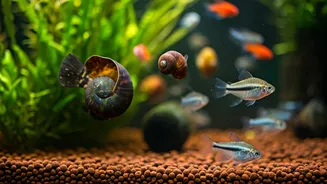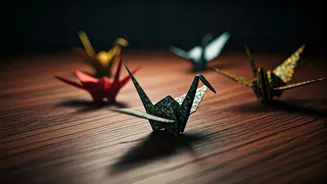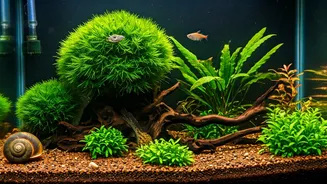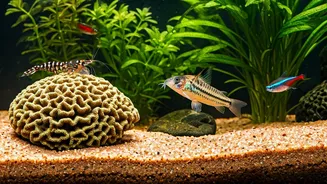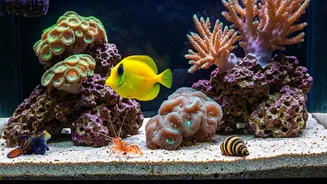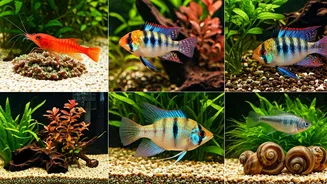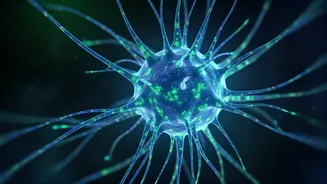Algae-Eating Snails
Snails are an excellent choice for a cleanup crew. They tirelessly munch on algae, which is a common nuisance in aquariums. These tiny workers help keep
the glass, decorations, and plants free from unsightly green growth. Furthermore, snails consume uneaten food and other detritus, preventing the buildup of harmful substances. One popular species is the Nerite snail, known for its voracious appetite for algae. Other effective choices include the Mystery snail and the Ramshorn snail. By introducing these snails, you can significantly reduce the effort required for manual cleaning, creating a cleaner and more aesthetically pleasing environment for your fish. Moreover, various snail species offer different appearances, adding diversity and visual interest to the aquarium's inhabitants. However, it's essential to research the needs of each snail species and ensure they are compatible with the other tank inhabitants, promoting a balanced and thriving aquarium ecosystem.
The Corydoras Catfish
Corydoras catfish, often called Corys, are small, peaceful bottom-dwellers, widely recognized for their effective scavenging abilities. These little fish spend their days searching the substrate for leftover food, ensuring that it doesn't decay and pollute the water. They are essential in preventing the accumulation of waste and maintaining the tank's cleanliness. Corydoras' continuous activity helps aerate the substrate, preventing the formation of anaerobic pockets, which can be harmful to fish health. There are many different species of Corydoras, each with unique patterns and sizes, making them a diverse addition to any community tank. They are generally peaceful and get along well with other non-aggressive fish. When choosing Corydoras, it's important to provide them with a sandy substrate, as they enjoy sifting through it in search of food. Moreover, a well-planted aquarium with plenty of hiding places is ideal for these shy creatures. Their role as efficient cleaners makes them a valuable asset in the ongoing task of maintaining a healthy and balanced aquarium environment.
The Amano Shrimp
Amano shrimp, also known as Japanese freshwater shrimp, are renowned for their incredible algae-eating capabilities. These small invertebrates can effectively control various types of algae, including the dreaded green spot algae that can be difficult to eliminate. Amano shrimp tirelessly scour the tank, consuming algae off plants, decorations, and the glass. They are highly effective at controlling algae outbreaks and preventing their spread. Furthermore, Amano shrimp are relatively easy to care for and are compatible with many community fish species. Their clear bodies and active foraging behavior provide a captivating sight. To keep them thriving, it's essential to provide a well-planted aquarium with plenty of hiding places and high-quality water conditions. They'll also appreciate supplemental feedings, such as algae wafers or blanched vegetables, to ensure they remain healthy and active. Their contribution to algae control makes them an essential element in establishing a balanced ecosystem within the aquarium, requiring minimal human intervention.
Bristlenose Plecos
Bristlenose plecos are a favored choice for aquarium cleaning due to their effectiveness in controlling algae and their compatibility with other tank mates. These bottom-dwelling fish possess a unique appearance, marked by their distinct bristly appendages around their mouths, which they use to graze on algae. They are particularly adept at removing algae from various surfaces, including glass, rocks, and plants. These plecos are relatively small compared to other plecos, making them suitable for a wide range of aquarium sizes. They are generally peaceful and well-suited for community tanks. They also consume other organic matter, contributing to a cleaner tank environment. While they primarily focus on algae, ensuring a balanced diet with additional vegetables or algae wafers is important for their well-being. Their role as natural cleaners makes them a valuable asset in maintaining a healthy and visually appealing aquarium. Their manageable size and peaceful temperament make them a great option for various aquarium setups.
Filter Feeders: Clams
Clams are filter feeders that quietly work behind the scenes, playing a vital role in water purification. These mollusks draw water into their bodies, filtering out suspended particles, uneaten food, and other debris. This process helps to clarify the water and reduces the accumulation of harmful substances. Clams add a unique element to an aquarium, requiring a specific substrate, usually sand, to bury themselves. They are an often overlooked member of the cleanup crew that greatly contributes to water quality. The presence of clams offers the added benefit of bringing a natural aesthetic to the aquarium landscape. While clams are beneficial, they do require care, including a steady supply of fine particles to feed on. They will add visual interest and biological diversity to the aquarium, while helping to maintain its clarity. These clams are a natural and often unnoticed powerhouse for a cleaner and healthier aquarium environment.
